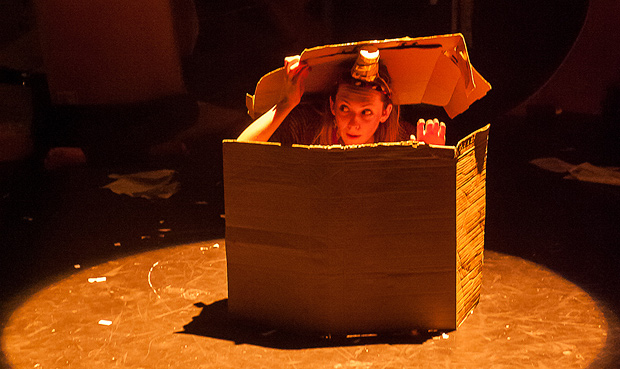‘One man’s trash is another man’s treasure’ is the tag line for Souvenirs. There’s a pile of boxes and shelves at the rear of the performance space, boasting a hotch-potch of everyday objects and ornaments, looking very much like a display in any one of the many Edinburgh charity shops just five minutes walk away on Nicholson Street. There are also old newspapers in the space, and three people sat in child-like (or teddy-bear, perhaps) poses, with roughly decorated cardboard boxes on their heads. They burst out and name themselves: One, Two, Three. They dash around in high spirits, playing games of various sorts, a nice evocation of the golden years of mid-childhood – those years when your old enough to be allowed outside for long spells, building camps and forming gangs.
There’s a new girl on the block, they name her Four, but she’s not sure she wants to take on the tag. She does, though, want to be one of the gang – but to be accepted she has to fulfil a dare. Break into the Birdman’s house and steal a jammy dodger.
She does – and she finds a lonely single man with stories to tell. His memories are evoked by the ensemble, who have now become (variously) his legendary journalist grandfather, his new-age poet mother, and his boyhood best friend turned lover.
It’s a story that has precedents – literature is full of these odd-bod adult/child confessional relationships, from Pip and Mrs Haversham onwards. Which is no bad thing – it’s an eternally interesting theme. I don’t have any gripe with the essential story, although feel it needs work. The key dramaturgical problem is the age of the child bearing witness – the tone of the game-playing, and the jittery physicality of the mock-children, has set up the suggestion that she is around 7 or 8 years old, perhaps 9 tops – but once in the company of the Birdman, she becomes someone far older, offering reflections and words of wisdom that would be pretty grown-up even for a teenager.
The writing is rather erratic – and it is thus not a surprise to see four writers (none of them the performers) credited on the play, along with a director and two producers. For this is a play, developed in association with Freshblood New Writing – despite its listing in the Dance and Physical Theatre sections of both the Edinburgh Fringe brochure and Zoo’s own marketing. It is a piece of new writing delivered by a young ensemble, who use add-on physical/visual theatre tricks as illustration of the text, rather than as the means to tell the tale. The promised object play is pretty old-school physical theatre – newspapers becoming masks or fluttering bird-like around; lengths of cloths becoming wings etc – although done well, and I do enjoy this aspect better than the poorly executed sections of early Complicite style hero-chorus movement work (slo mo movement across the stage; bodies lifted aloft – you know the sort of thing). No one on stage seems to have any particular aptitude for movement work, and there seems to be a mistaken belief that physical theatre is all about running around a lot, rather than it being what emerges from a performer trained in the use of their body as the storytelling medium.
The six onstage performers tear around the space morphing from one character to another, or providing ensemble support to other character’s stories. I do wish, though, that they had been discouraged from their terribly actor-ly acting. Their voices boom and project out into a small space that really doesn’t need this, and despite their proximity to us in this small space, with no divide between performers and audiences, our existence is never acknowledged. There are a couple of sections of monologue where the text is delivered over our heads into the void beyond. I suppose that’s what they teach you at acting school. It might work on a massive stage, but here it is just plain weird.
Apart from feeling strangely ignored as an audience member, fourth wall firmly intact, I also feel the whole show is just so busy that I’m starting to feel giddy and over-stimulated. So much needs cutting down, refining, carving into something more cohesive. It’s a text-based piece, and finding ways to deliver that text in a more cohesive, less shouty, and less busy way within the interesting scenographic context (the junk aesthetic, which I like a lot) would be the way forward, I feel.
To end on a positive note: the live music is good – always great to see live music in theatre and our multi-instrumental here works it well, with a mix of keyboards, recorder, guitar and floor tom, sometimes pure and simple, and sometimes looped. And the ensemble have to be commended for their physical energy and commitment.

